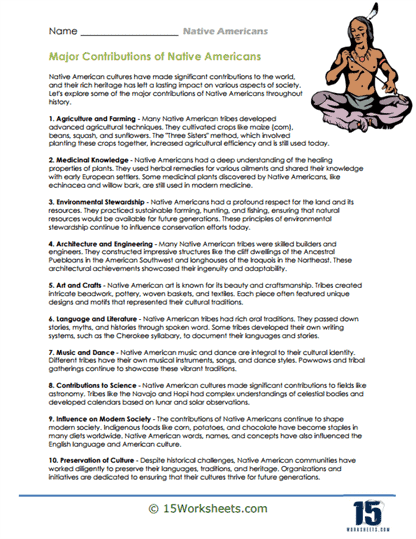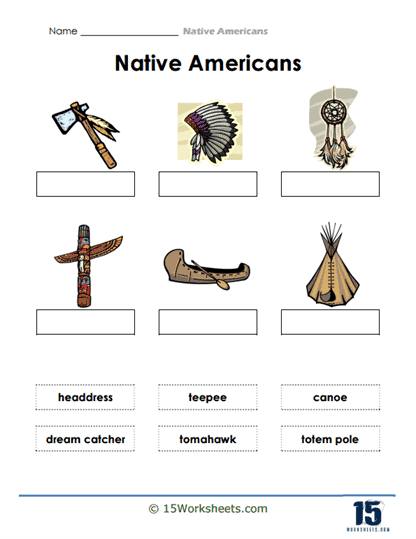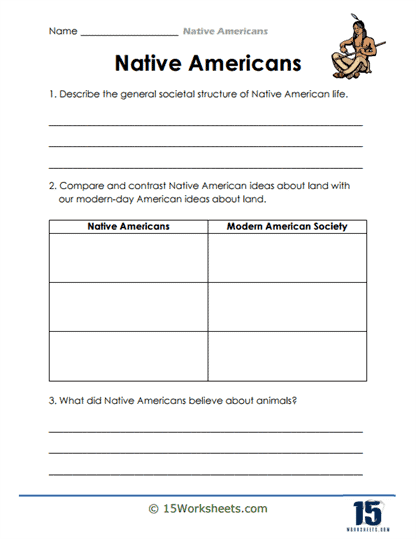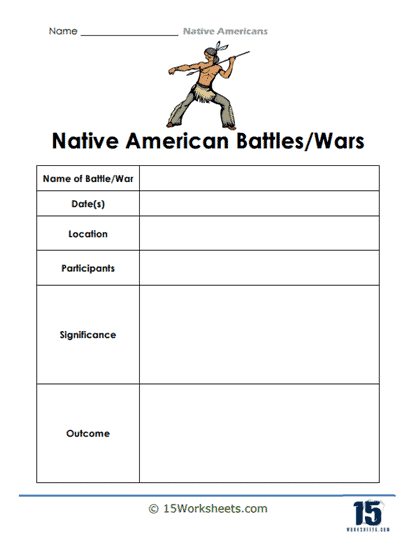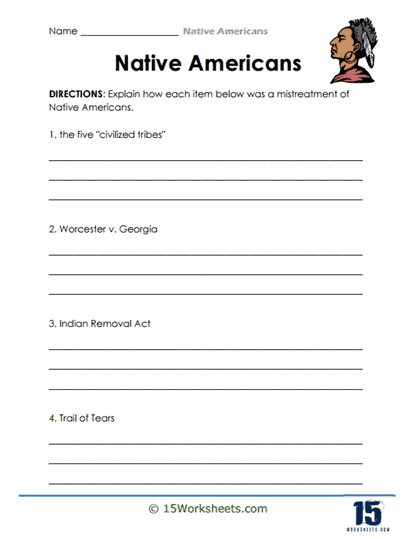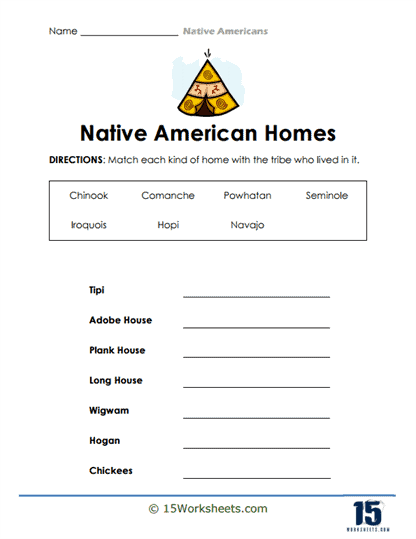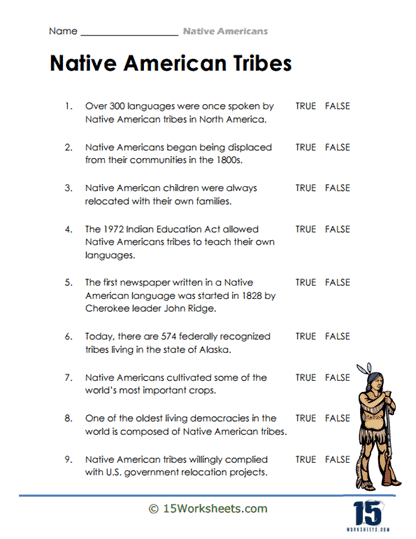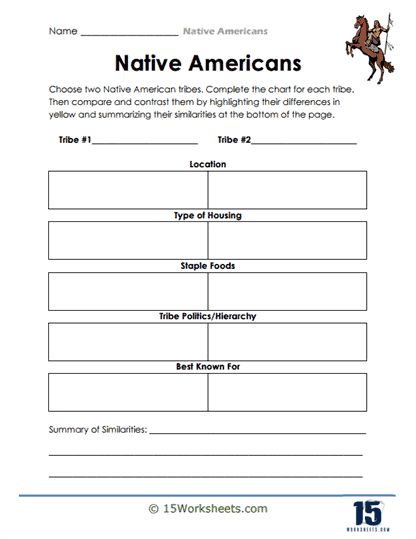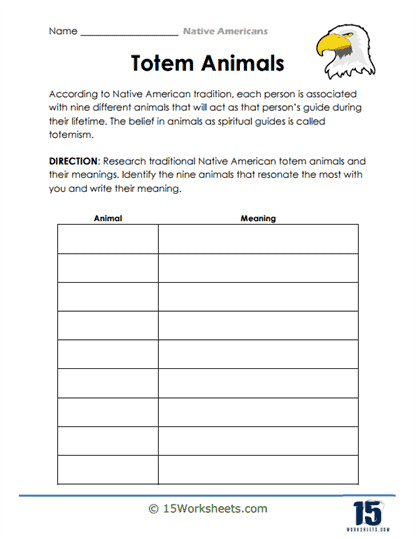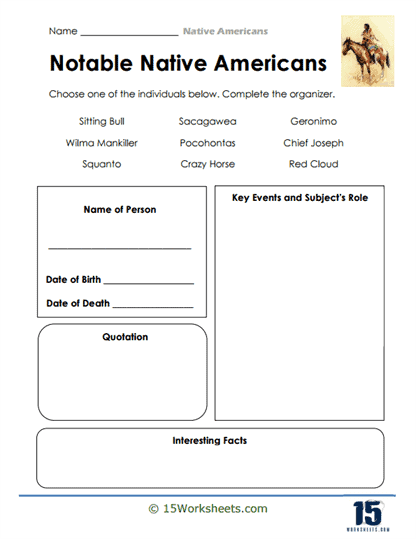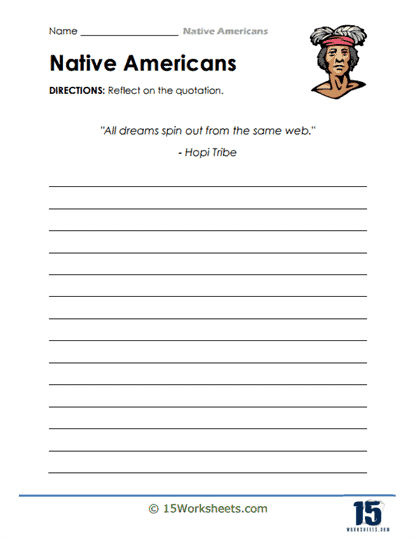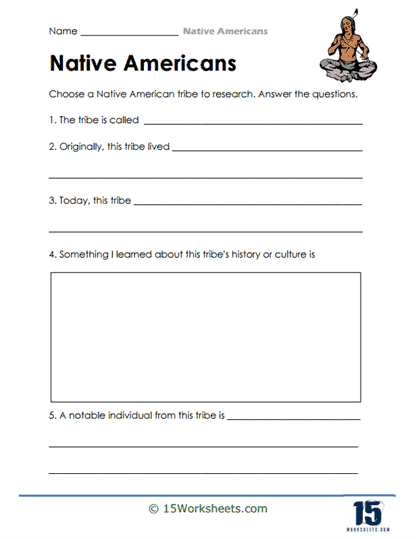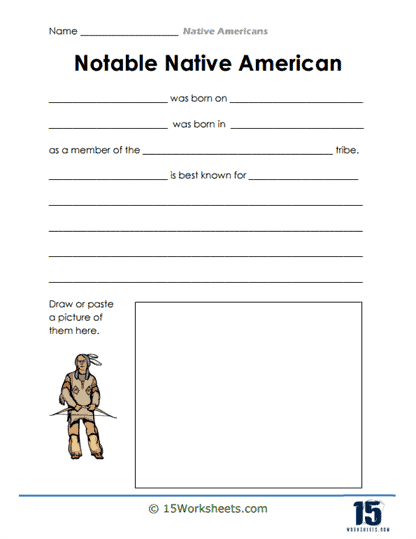Native Americans Worksheets
About These 15 Worksheets
These worksheets are meticulously designed to cater to students of different age groups, educational levels, and learning stages. By incorporating a diverse range of activities, they go beyond mere facts and dates to immerse students in the living histories, cultural traditions, and lasting contributions of Native American communities. Each worksheet is not just a passive exercise but an invitation to explore the vast and intricate tapestry of Native American life, both past and present. In engaging with these activities, students embark on a journey that challenges their preconceived notions and opens their minds to the diverse experiences that have shaped the United States and the wider Americas.
One of the most significant impacts of these worksheets is their ability to provide students with a more comprehensive and meaningful understanding of Native American cultures. Historically, Native American narratives have been underrepresented or misrepresented in educational systems, often reduced to simplistic or stereotypical portrayals. These worksheets seek to rectify this by offering an in-depth exploration of indigenous histories, belief systems, art, and ways of life that span thousands of years. Students are encouraged to delve into topics such as the complexity of Native American governance structures, the spiritual relationship with the natural world, and the linguistic diversity among tribes, all of which were fundamental to the development of their societies. In doing so, students are introduced to a more accurate and respectful portrayal of these cultures, dispelling the myths and inaccuracies that have too often dominated history books.
What makes these worksheets truly impactful is their variety. Rather than focusing solely on historical facts, they encourage students to engage with Native American heritage through creative and critical thinking exercises. Students may be tasked with analyzing primary source documents, such as treaties, oral histories, or artwork, enabling them to understand Native American perspectives on events like European colonization, forced relocation, and treaty negotiations. By working through these resources, students develop a nuanced view of history that incorporates multiple voices and experiences, rather than relying solely on the dominant narratives that have traditionally been taught.
The richness of Native American traditions is also emphasized through activities that explore music, art, and storytelling. For example, students might be asked to study the significance of traditional dances or the intricate symbolism found in beadwork and pottery. These creative assignments allow students to connect with Native American cultures on a personal level, encouraging them to appreciate not just the past, but the ongoing vitality of these traditions in contemporary Native American life. Through these cultural explorations, students gain insight into the spiritual and communal values that have sustained Native American communities across generations, fostering a sense of respect and admiration for their resilience and adaptability.
These worksheets help in developing critical thinking and communication skills. By engaging with complex topics such as land rights, cultural assimilation, and the enduring impacts of colonization, students are pushed to think deeply about historical injustices and their relevance to modern issues. They are prompted to draw connections between historical events and current conversations about indigenous rights, environmental justice, and cultural preservation. These exercises encourage students to think beyond the surface level and to question the systems of power and privilege that have shaped the world they live in. In doing so, they not only gain a deeper understanding of Native American experiences but also learn to approach contemporary social issues with empathy and informed perspectives.
As students work through these worksheets, they are not simply learning about the past—they are developing the tools to be more thoughtful and engaged citizens. They come to understand that Native American contributions to art, science, agriculture, governance, and environmental stewardship are not relics of a bygone era, but vital and ongoing aspects of American life. For instance, students may study the contributions of Native American agricultural practices, such as the cultivation of maize, beans, and squash, which continue to influence modern farming techniques. Or they might learn about the political systems of Native American nations, which in some cases inspired aspects of the U.S. Constitution, fostering a greater appreciation for the interconnectedness of cultures and the exchange of ideas across history.
In the process of engaging with these resources, students also cultivate a greater sense of empathy and respect for the diversity that exists within Native American communities. They come to recognize that Native Americans are not a monolithic group, but a multitude of distinct nations, each with its own unique history, language, and cultural practices. Through these worksheets, students are introduced to the concept of tribal sovereignty, learning about the ongoing efforts of Native American nations to assert their rights and maintain their cultural identities in the face of historical and contemporary challenges. This understanding is crucial in helping students appreciate the contemporary relevance of Native American struggles, such as those related to land protection, environmental stewardship, and cultural preservation.
Types of Exercises
Vocabulary Exercises – These segments focus on key terms related to Native American history, culture, and lifestyles. Students may engage in matching words with definitions, filling in the blanks, or using words in proper contexts. This activity builds a solid vocabulary foundation that is crucial for understanding the content discussed in the worksheets.
Reading Comprehension Questions – Students read passages about Native American history, cultures, or notable individuals and answer questions. These questions may range from factual, focusing on the who, what, when, and where, to more analytical, requiring students to infer meanings, motives, and outcomes. These exercises encourage students to analyze, compare, and contrast different aspects of Native American cultures or historical events. Students may be asked to think about the impact of certain events on Native communities or how Native American traditions differ from or resemble their own.
Biographies and Stories – Reading about the lives of significant Native American figures or traditional stories offers insights into the values, struggles, and achievements of these communities. This could also include analyzing folklore and understanding its moral and cultural significance. These activities involve comparing Native American cultures with other indigenous cultures around the world, highlighting both the diversity among indigenous peoples and the common challenges they face.
Timeline Activities – Students create or examine timelines of significant events in Native American history, helping them understand the sequence of events and their broader historical context. Prompts that encourage students to reflect on what they have learned and connect it to their own lives. This might involve writing essays, participating in discussions, or engaging in projects that draw parallels between historical events and contemporary issues.
Native American History and Culture
The history and culture of Native Americans represent a rich and diverse tapestry woven through the centuries, long before the arrival of European settlers. The indigenous peoples of the Americas developed an array of distinct cultures, each uniquely tailored to its environment, from the nomadic hunter-gatherer communities to advanced civilizations like the Maya, Aztec, and Inca. Societies like the Iroquois Confederacy are particularly notable for their sophisticated political systems. The economy of these cultures was as varied as the land, encompassing agriculture, hunting, fishing, and gathering, with crops such as corn, beans, and squash forming the agricultural backbone of many tribes.
Achievements
Artistic expression and architectural achievements were prominent in Native American societies, evident in intricate pottery, weaving, painting, and carving, as well as in architectural marvels like the cliff dwellings of the Ancestral Puebloans and the grand cities of Mesoamerica. Spirituality was deeply interwoven with the natural world, with practices and ceremonies often centered around agricultural cycles, celestial events, and reverence for ancestors and deities.
Indigenous societies across the Americas developed advanced agricultural techniques, such as the “Three Sisters” method of planting corn, beans, and squash together, revolutionizing food production. They also built complex civilizations, like the Maya, Inca, and Aztec, with impressive architectural marvels, mathematical systems, and writing systems. Additionally, Native Americans have made significant contributions to medicine, including the discovery of medicinal plants like quinine and the development of herbal remedies. Their intricate artwork, intricate beadwork, and intricate pottery are renowned for their craftsmanship and artistic expression.
Native American cultures have a profound connection to the environment, contributing to our understanding of sustainable practices and ecological wisdom. Despite centuries of adversity and marginalization, Native American achievements continue to enrich our global heritage and serve as a testament to their resilience and cultural richness.
Challenges and Hardships
The arrival of Europeans marked a significant and often tragic shift in Native American history. The introduction of diseases like smallpox led to a drastic population decline, as Native Americans had no immunity to these new illnesses. This period also saw extensive land loss and displacement due to treaties, wars, and forced removals, epitomized by events like the Trail of Tears. Despite these challenges, Native American communities resisted colonization through various means, including warfare, strategic alliances, and cultural adaptation, striving to maintain their traditions and social structures.
The 19th and 20th centuries were characterized by U.S. government policies that aimed to assimilate Native Americans and eradicate their cultures, most notably through the Indian Boarding Schools, which sought to assimilate Native American children into Euro-American culture. In response, Native Americans organized and fought for their rights, land, and sovereignty, with milestones like the Indian Citizenship Act of 1924 and the civil rights movements of the 1960s and 1970s marking significant progress in these struggles. The latter half of the 20th century witnessed a cultural renaissance, with a resurgence of interest in and respect for Native American cultures, leading to the revival of traditional practices, languages, and arts.
Modern Day
In contemporary times, Native American communities are at the forefront of preserving their cultural heritage, maintaining sovereignty over their lands, and pursuing economic development. Efforts to revitalize languages, traditions, and practices are ongoing, with many communities actively working to reclaim and celebrate their heritage. Challenges remain, however, as Native American communities often contend with issues like poverty, health disparities, and inadequate educational resources. Nonetheless, they remain actively involved in advocacy and activism, addressing critical issues such as environmental protection, the safeguarding of sacred sites, and the promotion of social justice and the rights of indigenous peoples globally.
The story of Native Americans is one of endurance, resistance, and a profound connection to tradition and the land. It’s a narrative that underscores the importance of acknowledging and respecting the diverse contributions of Native American communities to the broader fabric of history and society.


